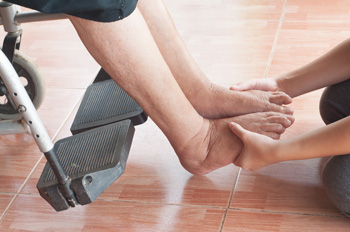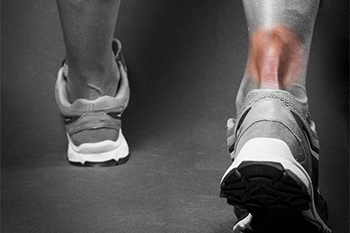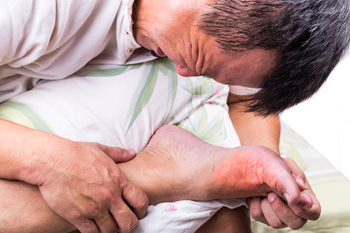Connect With Us
Blog

As people age, their feet naturally lose cushioning and elasticity, making them more vulnerable to pain and injury. Common foot complaints in the elderly include bunions, hammertoes, corns, calluses, and heel pain. Arthritis, poor circulation, and diabetes can also contribute to discomfort or deformity, affecting balance and mobility. Toenails may thicken or become ingrown, while dry skin can crack and lead to infection. Wearing supportive shoes, keeping feet clean and moisturized, and trimming nails carefully can help maintain foot health. Regular exercise that promotes circulation and flexibility also plays a key role in preventing problems. Foot pain should never be considered a normal part of aging. If you are an older adult experiencing discomfort or changes in your feet, it is suggested that you schedule an appointment with a podiatrist for a thorough evaluation and personalized treatment to stay active, comfortable, and independent.
Proper foot care is something many older adults forget to consider. If you have any concerns about your feet and ankles, contact Paul Hutchison, DPM from Hutchison Foot Clinic. Our doctor can provide the care you need to keep you pain-free and on your feet.
The Elderly and Their Feet
As we age we start to notice many changes in our body, but the elder population may not notice them right away. Medical conditions may prevent the elderly to take notice of their foot health right away. Poor vision is a lead contributor to not taking action for the elderly.
Common Conditions
- Neuropathy – can reduce feeling in the feet and can hide many life-threatening medical conditions.
- Reduced flexibility – prevents the ability of proper toenail trimming, and foot cleaning. If left untreated, it may lead to further medical issues.
- Foot sores – amongst the older population can be serious before they are discovered. Some of the problematic conditions they may face are:
- Gouging toenails affecting nearby toe
- Shoes that don’t fit properly
- Pressure sores
- Loss of circulation in legs & feet
- Edema & swelling of feet and ankles
Susceptible Infections
Diabetes and poor circulation can cause general loss of sensitivity over the years, turning a simple cut into a serious issue.
If you have any questions, please feel free to contact our office located in Memphis, TN . We offer the newest diagnostic and treatment technologies for all your foot care needs.

The Achilles tendon is located at the back of the leg near the heel and plays a vital role in foot movement by connecting the calf muscles to the heel bone. It enables pushing off the ground while walking or running. The two most common Achilles tendon injuries affecting this tendon are acute rupture and Achilles tendinopathy. An acute rupture involves a partial or complete tear, usually caused by sudden forceful movement, often during sports. It typically results in a popping sound, sharp pain in the calf, swelling, and difficulty walking. Achilles tendinopathy is a chronic condition caused by repetitive stress. Over time, small tears form in the tendon, leading to stiffness, pain with use, and a gradual decline in function. Over-training or increasing speed and distance too quickly can contribute to either condition. Treatment may involve surgery or wearing a boot to stabilize the foot. If you have an Achilles tendon injury, it is strongly suggested that you see a podiatrist who can help you with this condition.
Achilles tendon injuries need immediate attention to avoid future complications. If you have any concerns, contact Paul Hutchison, DPM of Hutchison Foot Clinic. Our doctor can provide the care you need to keep you pain-free and on your feet.
What Is the Achilles Tendon?
The Achilles tendon is a tendon that connects the lower leg muscles and calf to the heel of the foot. It is the strongest tendon in the human body and is essential for making movement possible. Because this tendon is such an integral part of the body, any injuries to it can create immense difficulties and should immediately be presented to a doctor.
What Are the Symptoms of an Achilles Tendon Injury?
There are various types of injuries that can affect the Achilles tendon. The two most common injuries are Achilles tendinitis and ruptures of the tendon.
Achilles Tendinitis Symptoms
- Inflammation
- Dull to severe pain
- Increased blood flow to the tendon
- Thickening of the tendon
Rupture Symptoms
- Extreme pain and swelling in the foot
- Total immobility
Treatment and Prevention
Achilles tendon injuries are diagnosed by a thorough physical evaluation, which can include an MRI. Treatment involves rest, physical therapy, and in some cases, surgery. However, various preventative measures can be taken to avoid these injuries, such as:
- Thorough stretching of the tendon before and after exercise
- Strengthening exercises like calf raises, squats, leg curls, leg extensions, leg raises, lunges, and leg presses
If you have any questions please feel free to contact our office located in Memphis, TN . We offer the newest diagnostic tools and technology to treat your foot and ankle needs.

A metatarsal fracture is a break in one of the long bones of the foot that connect the midfoot to the toes. Acute fractures often occur suddenly from trauma, such as dropping a heavy object on the foot, twisting an ankle, or experiencing a direct impact during sports. Symptoms may include immediate pain, swelling, bruising, and difficulty bearing weight. Proper diagnosis through imaging is essential to determine the severity and whether the fracture is displaced. Treatment may involve rest, immobilization with a cast or boot, and, in some cases, surgical fixation, where metal pins, screws, or plates are used to stabilize the bone. Aftercare is vital to ensure proper healing. This stage may include gradual weight bearing, targeted exercises, and supportive footwear to restore strength and mobility while preventing future injury. If you suspect a metatarsal fracture, it is suggested that you seek prompt evaluation and follow up care with a podiatrist for optimal recovery.
A broken foot requires immediate medical attention and treatment. If you need your feet checked, contact Paul Hutchison, DPM from Hutchison Foot Clinic. Our doctor can provide the care you need to keep you pain-free and on your feet.
Broken Foot Causes, Symptoms, and Treatment
A broken foot is caused by one of the bones in the foot typically breaking when bended, crushed, or stretched beyond its natural capabilities. Usually the location of the fracture indicates how the break occurred, whether it was through an object, fall, or any other type of injury.
Common Symptoms of Broken Feet:
- Bruising
- Pain
- Redness
- Swelling
- Blue in color
- Numbness
- Cold
- Misshapen
- Cuts
- Deformities
Those that suspect they have a broken foot shoot seek urgent medical attention where a medical professional could diagnose the severity.
Treatment for broken bones varies depending on the cause, severity and location. Some will require the use of splints, casts or crutches while others could even involve surgery to repair the broken bones. Personal care includes the use of ice and keeping the foot stabilized and elevated.
If you have any questions, please feel free to contact our office located in Memphis, TN . We offer the newest diagnostic and treatment technologies for all your foot care needs.

Gout is a form of inflammatory arthritis that often affects the joint at the base of the big toe. It is caused by a buildup of uric acid crystals in the joint, which leads to sudden and intense pain. Symptoms include redness, swelling, warmth, and extreme tenderness in the affected area, sometimes making it difficult to walk or even wear a sock. The pain often starts at night and may feel sharp, throbbing, or burning. Triggers for gout can include a diet high in purines, alcohol consumption, dehydration, certain medications, and underlying health conditions. A podiatrist can help diagnose gout through a physical examination, patient history, and possibly lab tests to measure uric acid levels. Treatment options may involve anti-inflammatory medications, dietary recommendations, lifestyle changes, and long-term management strategies to prevent future flare-ups. If you experience sudden foot pain or suspect gout, it is suggested that you make an appointment with a podiatrist to receive proper care and relief.
Gout is a painful condition that can be treated. If you are seeking treatment, contact Paul Hutchison, DPM from Hutchison Foot Clinic. Our doctor will treat your foot and ankle needs.
What Is Gout?
Gout is a form of arthritis that is characterized by sudden, severe attacks of pain, redness, and tenderness in the joints. The condition usually affects the joint at the base of the big toe. A gout attack can occur at any random time, such as the middle of the night while you are asleep.
Symptoms
- Intense Joint Pain - Usually around the large joint of your big toe, and it most severe within the first four to twelve hours
- Lingering Discomfort - Joint discomfort may last from a few days to a few weeks
- Inflammation and Redness -Affected joints may become swollen, tender, warm and red
- Limited Range of Motion - May experience a decrease in joint mobility
Risk Factors
- Genetics - If family members have gout, you’re more likely to have it
- Medications - Diuretic medications can raise uric acid levels
- Gender/Age - Gout is more common in men until the age of 60. It is believed that estrogen protects women until that point
- Diet - Eating red meat and shellfish increases your risk
- Alcohol - Having more than two alcoholic drinks per day increases your risk
- Obesity - Obese people are at a higher risk for gout
Prior to visiting your podiatrist to receive treatment for gout, there are a few things you should do beforehand. If you have gout you should write down your symptoms--including when they started and how often you experience them, important medical information you may have, and any questions you may have. Writing down these three things will help your podiatrist in assessing your specific situation so that he or she may provide the best route of treatment for you.
If you have any questions, please feel free to contact our office located in Memphis, TN . We offer the newest diagnostic and treatment technologies for all your foot care needs.
